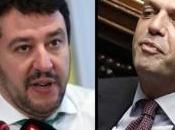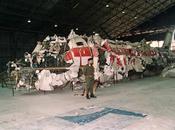 Questa volta vittima di un attentato terroristico-mafioso è il giudice Paolo Borsellino e i cinque uomini della sua scorta. Insieme a loro c’era anche Antonio Vullo, unico sopravvissuto all’esplosione delle 16.58.
Questa volta vittima di un attentato terroristico-mafioso è il giudice Paolo Borsellino e i cinque uomini della sua scorta. Insieme a loro c’era anche Antonio Vullo, unico sopravvissuto all’esplosione delle 16.58.E’ una carneficina. «Si notava una scena di guerra – scrive nel primo rapporto di polizia stilato dal sovrintendente Vincenzo Alberghina che arriva sul posto a bordo della volante “21” – con tante auto distrutte, mentre altre bruciavano ancora, proiettili che sparavano da soli perché a contatto con il fuoco, gente dei palazzi che chiedeva aiuto».
Il dopo strage è costituito da una serie impressionante di abbagli e fallimenti giudiziari (basti pensare che sono stati celebrati per intero ben tre processi ed è in corso il quarto proprio in questi giorni). Sullo sfondo si muove sempre il perverso quadro fatto di mafia, politica, errori investigativo-giudiziari e depistaggi.
Per quasi vent’anni la ricostruzione al vaglio degli inquirenti, e ritenuta attendibile, è stata quella di Vincenzo Scarantino, criminale di basso lignaggio del rione della Guadagna: per 14 anni i pubblici ministeri e i giudici, dal primo grado alla cassazione hanno creduto alla sua versione, al fatto che fosse stato lui a rubare e portare sul posto la 126 poi esplosa in via d'Amelio, e addirittura a riunirsi per decidere l'esecuzione della strage di via d'Amelio.
Tra forzature degli investigatori (a costruire la versione di Scarantino aveva contribuito il superpoliziotto Arnaldo La Barbera, poi deceduto nel 2002) di allora e cecità dell'apparato giudiziario si è costruita una balla lunga 15 anni. Lo hanno chiamato depistaggio. Eppure, per esempio, quello Scarantino non fu mai messo a confronto in aula con quelli ch'egli accusava. Il caso più clamoroso fu Gaetano Murana, incensurato, professione netturbino, contro di lui la sola parola dello Scarantino. Arrestato nel 1994, scarcerato nel 2011 perchè innocente. Ma ci sono tutta una serie di circostanze che dovrebbero come minimo far porre qualche domanda alla pletore di togati che ha permesso tale scempio giudiziario.
Ilda Boccassini nel 1994 mise in guardia investigatori e pubblici ministeri di Palermo «L'inattendibilità delle dichiarazioni rese da Scarantino - scrivevano in una nota nel 1994 Boccassini e l'altro pm che non credeva alla ricostruzione Scarantino, Saieva - suggerisce di riconsiderare il tema dell'attendibilità generale di tale collaboratore, anche perché lo stesso ha, recentemente modificato la propria posizione in ordine ad una circostanza che assume estremo rilievo». Quella circostanza è la stessa di cui oggi si autoaccusa Gaspare Spatuzza e per la quale viene ritenuto credibile, cioè la vicenda del furto della Fiat 126, successivamente imbottita di esplosivo.
«Rinviare il compimento dei necessari atti d'investigazione potrebbe avere come effetto di lasciare allo Scarantino una via aperta verso nuove piroettanti rivisitazioni dei fatti». Rivisitazioni piroettanti che si sono verificate e hanno retto fino in cassazione, fino a quando è arrivata ormai tre anni fa la riapertura delle indagini su di via D'Amelio.
Deposizioni quelle di Scarantino che fecero sospettare la manina di qualche puparo dietro le sue dichiarazioni e la possibile compresenza di una ‘trattativa‘ tra Stato e mafia per frenare le bombe del terrorismo mafioso... [to be continued]
Luca Rinaldi | @lucarinaldi
Stories of dishonor: via d'Amelio, four trials and little truth (part 1)
An Italy still shaken by the destroyed highway of Capaci and with a political crisis in full deflagration, must now deal with yet another explosion. It happens on July 19th 1992, three months after the disaster where Giovanni Falcone was killed. This time the victim of a terorristic-mafia attack is the judge Paolo Borsellino and five men of his escort. Together with them was also Antonio Vullo, only survivor of the 16.58 explosion.
It's a massacre. "You could see a war scene - writes in the first police report written by Vincenzo Alberghina, who arrives onboard of his 21 police vehicle - with many destroyed cars, others still burning, bullets that fire themselves because of the contact with fire, people in the buildings crying for help."
The aftermath is constituted by an impressing series of mistakes and judiciary failures (just think about the fact that three trials have been celebrated fully, and the fourth is in course during these very days). In the background we see the same perverted scene made of mafia, politics, investigative-judiciary errors and framings.
For almost 20 years the reconstructions of the investigators, and held as believable, was that of Vincenzo Scarantino, a low profile criminal from the Guadagna rion: for 14 years the judges, from the first degree until the Cassazione, have believed his version, the fact that he was the one to steal and bring on the spot the 126 that exploded in via D'Amelio, and even have a meeting to decide the execution of the via D'Amelio slaughter.
Between the forcing of investigators (in building Scarantino's version there was some contribution from the agent Arnaldo La Barbera, who died in 2002) from back then and the blindness of the judiciary apparatus, they managed to build a lie 15 years long. They called it screening. And yet, for example, that Scarantino was never confronted in court with those whom he accused. The most incredible case was that of Gaetano Murana, without precedents, garbage collector, against him the only word of Scarantino. Arrested in 1994, liberated in 2011 because innocent. But there are a series of circumstances that should at least make a few questions rise from the series of judges who have allowed this judiciary disaster.
Ilda Boccassini in 1994 warned investigators and judges of Palermo: "The unreliability of the declarations given by Scarantino - wrote in a note in 1994 Boccassini and the other PM who didn't believe to Scarantino's reconstructions, Saieva - suggests to riconsider the matter of the general reliability of this collaborator, also because he has recently modified his position regarding a circumstance that assumes extreme relevance." That circumstance is the same of which today Gaspare Spatuzza incriminates himself, and for which he is considered beliavable, which is the matter of the theft of the Fiat 126, later filled with explosives.
"Delaying the completion of the necessary acts of investigation might have the effect of leaving Scarantino an open door towards pivoting revisitations of the facts". Pivoting revisitations that have indeed happened and have worked until Cassazione, until three years ago the inquiries on via D'Amelio have finally been reopened.
Declarations, those of Scarantino, that suggested the hand of some puppetmaster behind his words and the possible presence of a State - mafia "treaty" in order to stop the bombs of mafia terror...
Luca Rinaldi | @lucarinaldi







